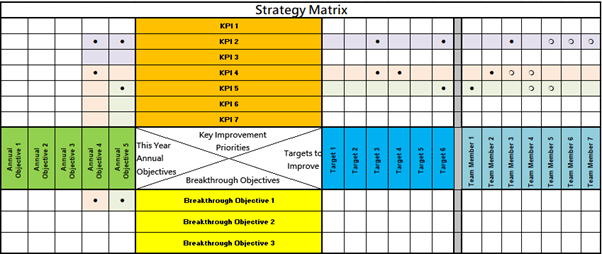The CI Directorate Strategic Planning Day 2023 quickly became more than one day. This was our first venture into systematic strategy creation and implementation using the Hoshin Kanri principles.
The first day was spent establishing where we were, a baseline of the Directorate’s performance. The whole team did this via a group SWOT (Strengths, Weaknesses, Opportunities and Threats) analysis and reference to existing performance measures.
There followed a discussion and creation of the vision for the Directorate and some ideas around a mission and an examination of our ‘customers’ past, present, and future.
Using all this foundational information, defining where the Directorate is currently and where it wants /needs to be, the team then brainstormed ideas to bridge the gap, identified new paths to take, and current practices that were not aligned or producing benefits.
Day one ended with a 5-dot prioritisation game. From the 100’s of ideas generated through the brainstorm exercise, if each person could only implement five, which five would they be? This gave an indication of the high-level prioritisation.
During the lead up to day two the volume of information from day one was reviewed and categorised into an affinity chart with like/similar topics creating broadly identified areas to improve in.
Day two had the team all together again and using the basis of day one content and the categorised outputs identified, the Directorate breakthrough goals, ambitious year one goals, and the Key Improvement Priorities (KIPs) to deliver. The KIPs were broadly aligned to the affinity chart categories from the day one output.
These three areas were visually represented in our Strategy Matrix (the x-matrix in Hoshin Kanri). Once visual on the strategy matrix it is easy to map the relationships of which year one goals lead to delivering a breakthrough goal and how certain KIP’s deliver the year one goals. Mapping these and adjusting for any gaps gave the directorate a complete, aligned set of work to complete in the year.
The team then identified what measures of the Directorate performance the KIPs would impact with the work, and finally who would lead each KIP workstream and who would support and be involved.
The strategy matrix allows all of this information to be clear visually, which is more challenging with only the written word.

At the end of day two we had our strategy clear, our workstreams populated, and an agreed method of visualising workstream progress and controlling the overall implementation with a monthly meeting.
After 10 months of implementation and our 2024 Strategy Day looming later this month what did we learn that might help others embarking on this journey, and did we see progress?
Time
Starting from scratch will take more time that you think. The Directorate approach of splitting 'Creation' into day one and 'Implement' into day two was the right one, but these should be closer together, one week apart is ideal. New concepts such as X-matrix and A3 need time to explain and embed.
Naming
Adopt a ‘call it what it is’ in plain speak policy moving forward. A spade is a spade not an ‘agricultural soil removal implement’. There is a real allure in this kind of work to use highly stylised business buzz words and terms. Please resist and use simple English to aid clarification of what we are doing and why.
KIP Workstream Lead Role
- Plan meetings
- Monitor progress.
- Update A3 with progress.
- Represent workstream updates at Strategy meetings.
- Feedback issues.
- Workstream start dates. The goal is to move the needle within the year, you know your work pattern best, plan accordingly.
KIP Workstream Teams Membership
Caution against these teams being too large. Essential criteria are lead, subject matter expert, critical friend. Be aware of FOMO (fear of missing out), the reporting system will allow you to find out what is happening.
KIP Workstream Volume and Identification
Ideally, have single purpose workstreams to be able to focus better on development and spend less time sorting out duplication with other workstreams. To do this once they are identified, take 10 minutes to discuss what this might contain, then identify the benefit. Once this is completed look at impact effort or any priority/dependence. These 10 minutes will remove overlap or activity duplication.
A3 Use (A3 is a tool to track workstream progress visibly)
It is essential to have something simple to track the progress of each workstream. A planner with To Do, Doing, Done, for example would serve the purpose. Actions can be allocated, everyone can access, dates and labels can be used. Keep it simple to use and visual to chart progress.
KIP Workstream Meetings
Keep these short and in the right cycle time. It’s a real advantage for each workstream to have a ‘sandbox’ area in Miro for the teams to use as necessary to discuss ideas and brainstorm. This is purely for the teams not part of reporting.
Reporting
Identify measures that have purpose and meaning, not because they exist and are easy to measure. This part is important to identify the progression of the directorate and the impact of the strategy. If performance measurement is not something you currently do well, consider it to be a KIP workstream and develop robustly for the coming year.
The above are some of the key lessons we have learned in year one.
To conclude let us refer back to our initial question. Is Hoshin Kanri a sustainable system of Strategy Implementation?
I’m tempted to write ‘tune in next time’ as once we complete this year’s annual plan the answer will be tangibly clearer as we see the annual impact of strategic implementation on our measures.
For now, however some softer benefits
- The plan is visual, any member of the Directorate can explain what we want to achieve to anyone who asks in consistent terms.
- Success is measurable.
- Everyone is included in creation and delivery as either lead or workstream member.
- Any team member can articulately link the Institutional Strategy to the Directorate Strategy to the work they do.
- Any team member can align the Directorate Strategy to their individual Annual Development Review.
- The team have worked on improving the implementation through the year, motivated to do it better.
And one evidential benefit from a workstream focussed on increasing engagement.
- Online Training conversion from Booked to Attended increase 18 percentage points to 82%
- Online training attendance increased overall by 55 attendees with 15 sessions outstanding.
- Staff Engagement increased by 5 attendees with 4 months outstanding.
Is Hoshin Kanri a sustainable system of Strategy Implementation? The signs are very positive.
I personally feel very optimistic about next year with the adopted learnings of year one, a solid strategy to build on, and dynamic system to implement.
Next month’s blog will feature our 2024 annual planning session and the tangible impact of our Strategy efforts in 2023.


